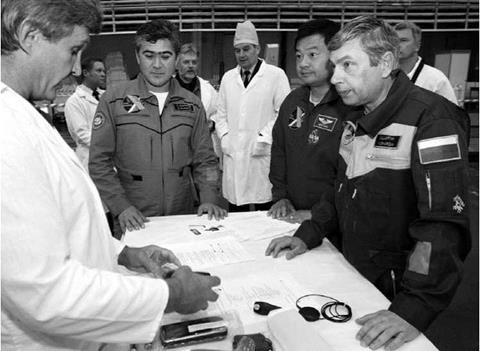. SOYUZ TMA5
Flight Crew
CHIAO, Leroy, 44, civilian, US ISS-10 commander and science officer,
4th mission
Previous missions: STS-65 (1994); STS-72 (1996); STS-92 (2000) SHARIPOV, Salizhan Shakirovich, 40, Russian Air Force, ISS-10 flight engineer and Soyuz commander, 2nd mission Previous mission: STS-89 (1998)
SHARGIN, Yuri Georgiyevich, 44, Russian Military Space Forces, Soyuz flight engineer
Flight Log
Russian businessman Sergei Polonsky was scheduled to become the third space flight participant on this flight, but he failed the medical and was replaced by cosmonaut Yuri Shargin. Shargin was a representative of the Russian Space Forces, and became the first member of that force to be selected for cosmonaut training in 1996. He had completed a full course of cosmonaut training, including simulations with the Mir complex. This was perhaps his only chance of a space flight, and he carried out his own programme of scientific studies, although it was stressed that none of these were military in nature as such investigations are banned on ISS. Earth observations and a daily biomedical programme were the main focus of his week on the station. Shargin returned to Earth on 24 October, along with the ISS-9 crew.
There had been a delay to the launch of TMA5, reportedly caused on 15 September by a small explosion in a separation bolt on the Soyuz docking ring. A leaking pressure membrane in a small tank of liquid hydrogen peroxide had also ruptured, and procuring the replacement from the TMA6 craft that was under construction at Energiya in Moscow delayed the planned 9 October launch to 14 October. Once on
|
ISS 10 crew: Sharipov (left) and Chiao (centre) with Yuri Shargin (right) review crew equipment during the final check of the Soyuz TMA5 spacecraft on 9 October 2004 at the Baikonur Cosmodrome, Kazakhstan |
orbit, problems with an intermittent forward-firing thruster on TMA5 resulted in Sharipov having to conduct a manual docking with the station.
During the tenth expedition on ISS, the two-man crew would complete two Pirs – based EVAs, receive two Progress re-supply craft and relocate their TMA from the Pirs module (where they docked) to the Zarya module. There were also further problems with the Elektron unit, repairs to US EVA suits and Russian Orlan M suits, upgrades to the computer software, the breakdown of the station’s toilet in the Zvezda living quarters, the replacement of a faulty heat exchanger in the Quest airlock module, and the relocation of the Canadarm2 to deal with. Fitted around all of this was the routine work with the experiments aboard the station and general housekeeping chores.
During the first EVA (26 Jan 2005 for 5 hours 28 minutes), Sharipov photographed the residue around vents on the outside of Zvezda, generated from by-products of the Elektron and carbon dioxide removal systems. The two men also completed the installation of a work platform and deployed a European commercial experiment and a Russian experiment. The second EVA (28 Mar for 4 hours 30 minutes) included the installation of cables and antennas on Zvezda in support of future
ATV dockings and the deployment by hand of a small satellite to test new control techniques.
In late November, there were concerns that the food supplies onboard the station were less than expected. Three audits of onboard supplies indicated that the rations would run out by mid-January. It was intended that there should be a 45-day buffer of supplies to cope with any delay in the launch of the next re-supply vessel, but it was found that the records of inventory were not being kept as accurately as they should have been, probably due to the increased workload that the smaller crews were having to cover. Re-supply craft Progress M51 resolved the immediate problem by delivering 200 kg of food supplies, which would last until Progress M52 arrived in March.
On the ground, NASA was working toward the resumption of Shuttle flights, with the STS-114 mission planned for May 2005. Though no construction work would be conducted on the first two missions (designated Return-to-Flight missions 114 and 121), there would be an opportunity to deliver supplies, spares and other logistics, as well as removing the significant amount of unwanted gear that had built up since the departure of Endeavour (STS-113) in December 2002. During the early weeks of 2005, the crew began packing and stowing items that were to be returned in bundles on the floor of Zvezda and in a stowage rack in the Destiny lab.
Near the end of their tour of duty, the ISS-10 crew were joined by their replacements, the ISS-11 crew, who arrived on Soyuz TMA6 in April 2005. Also on board the new TMA was Italian astronaut Roberto Vittori, who brought some much-enjoyed Italian delicacies with him for the period of joint activities prior to returning to Earth with the ISS-10 crew aboard TMA5.
Milestones
242nd manned space flight
98th Russian manned space flight
91st manned Soyuz mission
5th manned Soyuz TMA mission
38th Russian and 92nd flight with EVA operations
9th ISS Soyuz mission (9S)
7th ISS visiting mission (VC-7)
4th resident caretaker ISS crew (2 person)











